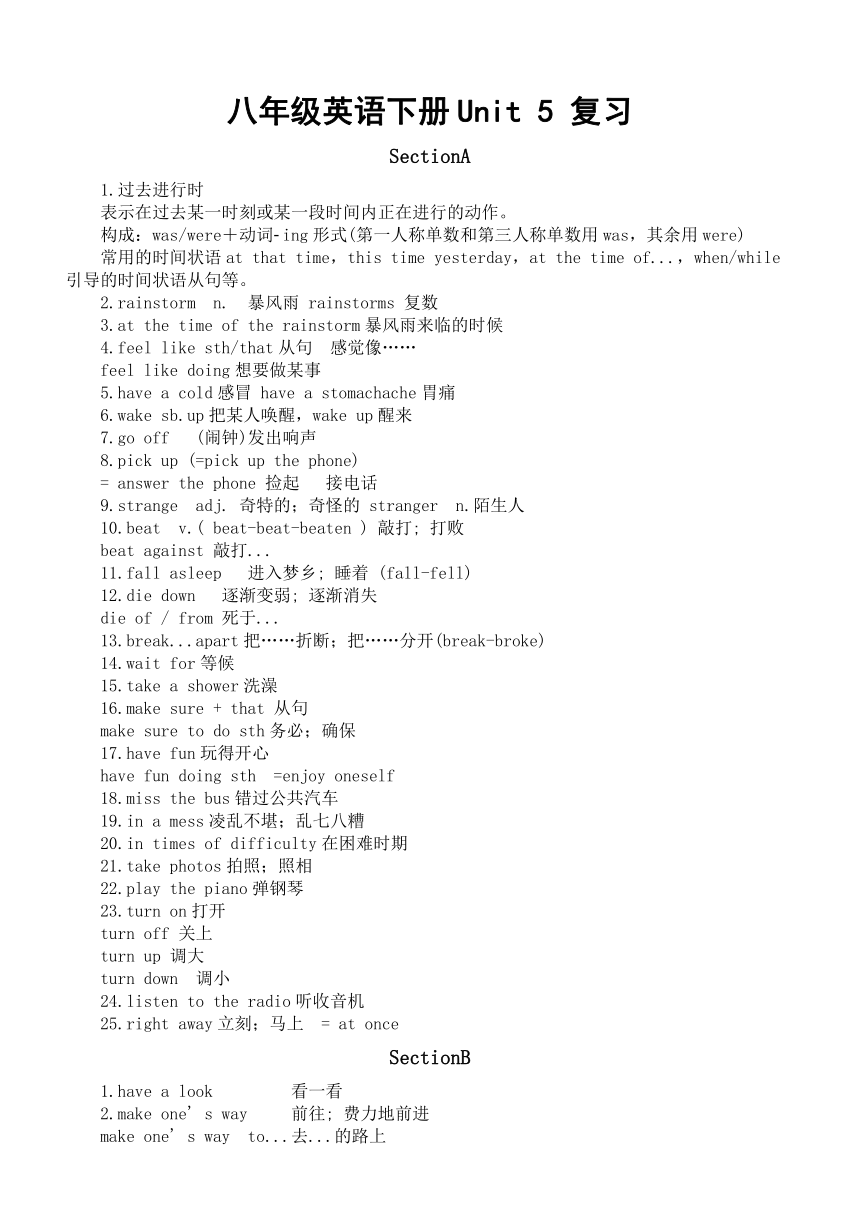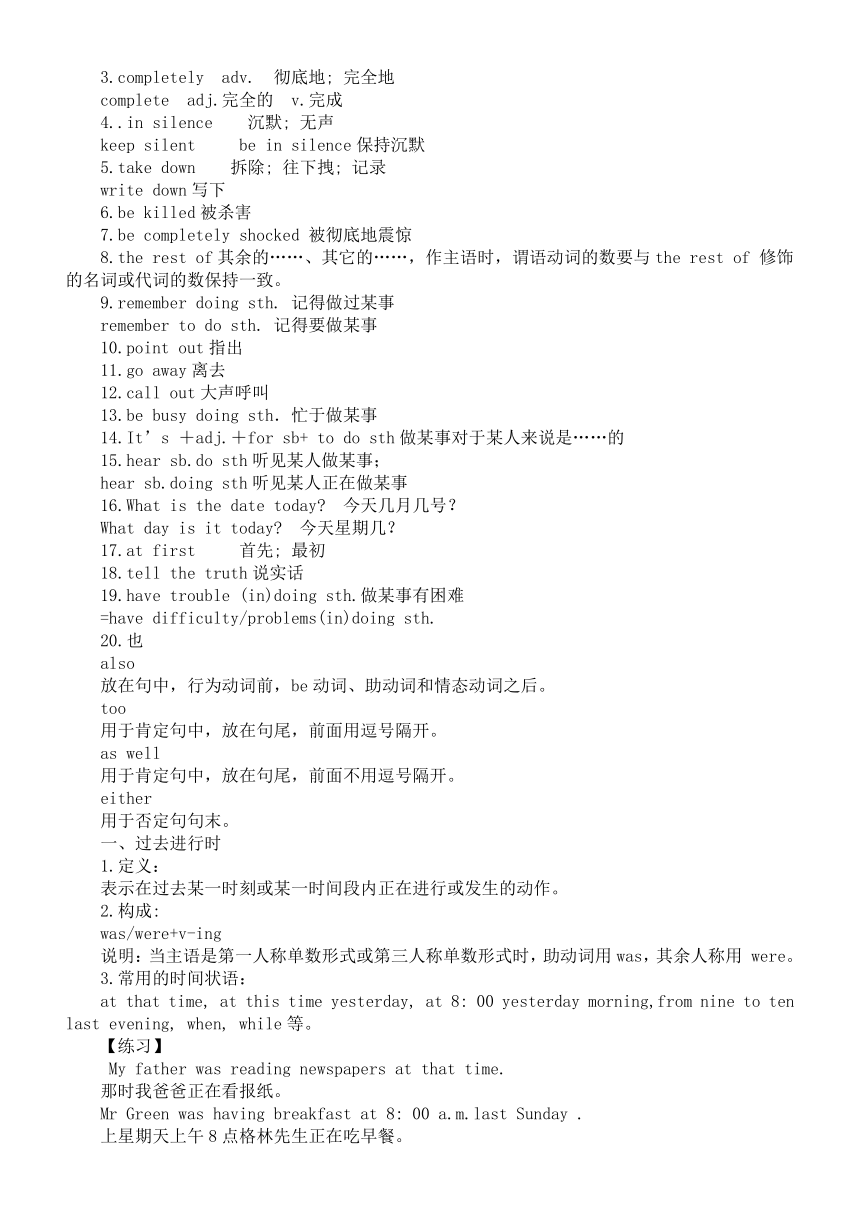Unit 5 What were you doing when the rainstorm came?语法短语复习人教版英语八年级下册
文档属性
| 名称 | Unit 5 What were you doing when the rainstorm came?语法短语复习人教版英语八年级下册 |  | |
| 格式 | docx | ||
| 文件大小 | 22.7KB | ||
| 资源类型 | 教案 | ||
| 版本资源 | 人教新目标(Go for it)版 | ||
| 科目 | 英语 | ||
| 更新时间 | 2024-04-21 21:13:48 | ||
图片预览


文档简介
八年级英语下册Unit 5 复习
SectionA
1.过去进行时
表示在过去某一时刻或某一段时间内正在进行的动作。
构成:was/were+动词 ing形式(第一人称单数和第三人称单数用was,其余用were)
常用的时间状语at that time,this time yesterday,at the time of...,when/while引导的时间状语从句等。
2.rainstorm n. 暴风雨 rainstorms 复数
3.at the time of the rainstorm暴风雨来临的时候
4.feel like sth/that从句 感觉像……
feel like doing想要做某事
5.have a cold感冒 have a stomachache胃痛
6.wake sb.up把某人唤醒,wake up醒来
7.go off (闹钟)发出响声
8.pick up (=pick up the phone)
= answer the phone 捡起 接电话
9.strange adj. 奇特的;奇怪的 stranger n.陌生人
10.beat v.( beat-beat-beaten ) 敲打; 打败
beat against 敲打...
11.fall asleep 进入梦乡; 睡着 (fall-fell)
12.die down 逐渐变弱; 逐渐消失
die of / from 死于...
13.break...apart把……折断;把……分开(break-broke)
14.wait for等候
15.take a shower洗澡
16.make sure + that 从句
make sure to do sth务必;确保
17.have fun玩得开心
have fun doing sth =enjoy oneself
18.miss the bus错过公共汽车
19.in a mess凌乱不堪;乱七八糟
20.in times of difficulty在困难时期
21.take photos拍照;照相
22.play the piano弹钢琴
23.turn on打开
turn off 关上
turn up 调大
turn down 调小
24.listen to the radio听收音机
25.right away立刻;马上 = at once
SectionB
1.have a look 看一看
2.make one' s way 前往; 费力地前进
make one' s way to...去...的路上
3.completely adv. 彻底地; 完全地
complete adj.完全的 v.完成
4..in silence 沉默; 无声
keep silent be in silence保持沉默
5.take down 拆除; 往下拽; 记录
write down写下
6.be killed被杀害
7.be completely shocked 被彻底地震惊
8.the rest of其余的……、其它的……,作主语时,谓语动词的数要与the rest of 修饰的名词或代词的数保持一致。
9.remember doing sth. 记得做过某事
remember to do sth. 记得要做某事
10.point out指出
11.go away离去
12.call out大声呼叫
13.be busy doing sth.忙于做某事
14.It’s +adj.+for sb+ to do sth做某事对于某人来说是……的
15.hear sb.do sth听见某人做某事;
hear sb.doing sth听见某人正在做某事
16.What is the date today 今天几月几号?
What day is it today 今天星期几?
17.at first 首先; 最初
18.tell the truth说实话
19.have trouble (in)doing sth.做某事有困难
=have difficulty/problems(in)doing sth.
20.也
also
放在句中,行为动词前,be动词、助动词和情态动词之后。
too
用于肯定句中,放在句尾,前面用逗号隔开。
as well
用于肯定句中,放在句尾,前面不用逗号隔开。
either
用于否定句句末。
一、过去进行时
1.定义:
表示在过去某一时刻或某一时间段内正在进行或发生的动作。
2.构成:
was/were+v-ing
说明:当主语是第一人称单数形式或第三人称单数形式时,助动词用was,其余人称用 were。
3.常用的时间状语:
at that time, at this time yesterday, at 8: 00 yesterday morning,from nine to ten last evening, when, while等。
【练习】
My father was reading newspapers at that time.
那时我爸爸正在看报纸。
Mr Green was having breakfast at 8: 00 a.m.last Sunday .
上星期天上午8点格林先生正在吃早餐。
Jim was doing his homework when the teacher came in.
老师进来的时候,吉姆正在做作业。
4.基本句式:
(1)肯定句:主语+ was/were+v-ing+其他.
I was sleeping at ten last night.昨天晚上10点我在睡觉。
(2)否定句:主语+wasn' t/weren't+v-ing+其他
I wasn’t sleeping at ten last night .昨天晚上10点我没在睡觉。
(3)一般疑问句: Was/Were主语+v-ing+其他
肯定回答:Yes,主语+was/were
否定回答:No,主语+wasn' t/weren't
【练习】
——Were you sleeping at ten last night
昨天晚上10点你在睡觉吗?
—— Yes, I was./ No, I wasn’t.
对,是的。/不,我没有。
5.过去进行时与一般过去时的区别:
过去进行时表示在过去某一时刻或某一段时间内正在进行或发生的动作,强调动作正在进行;
而一般过去时表示过去发生的动作或存在的状态,多指动作已经完成。
【练习】
I was making my way to the small mountain village at this time yesterday.
昨天的这个时候我正前往那个小山村。
I went shopping yesterday.昨天我购物了。
【练习】
They ___ about the test at this time yesterday.
A.were talking...B.are talking
C.have talked...D.will talk
解析:我们可用“关键信息法”解答本题。根据时间状语 this time yesterday(昨天这个时候)为过去某个具体时间可知,此处应用过去进行时,表示过去某个时间正在发生的动作,其构成为: was/were+v-ing。故选A
答案:A
二、when与while引导的时间状语从句
when和 while都可用作连词,意为“当…的时候”,都可用来引导时间状语从句,它们具体用法如下:
1.when的用法
(1)when指时间点也可指时间段,其从句的谓语动词可以是延续性的,也可以是非延续性的。
eg :When I arrived the station, they were waiting for me.
当我达到车站时,他们正在等我。
(2)when引导的从句的谓语动作可在主句谓语动作之前、之后发生或与之同时发生。
【练习】
When he finished his homework, he played games.
当他完成作业后,他就玩游戏了。(完成作业在前)
When I got to the museum, the door waslosed.当我达到博物馆时,门已经关上了。
(到博物馆在后)
(3)当主句是一般将来时态时,其从句用一般现在时表示将来。
【练习】
I'll call you when I get there.
当我达到那里时我将给你打电话。
2.whie的用法
(1)whle指时间段,其从句的谓语动词必须是延续性的。
【练习】
While I was waiting for the bus, I met her.
当我正在等公共汽车时,我遇见了她。
(2)强调主从句动作同时进行时,常用 while引导从句。此时主从句常用进行时。
eg;They were rowing boats while we were climbing the hill当我们在爬山时,他们在划船
(3)强调主句动作发生时,从句动作正在进行,
常用 while引导从句。主句常用一般过去时或一般现在时,从句常用进行时。
儿歌:It began to rain while we were having dinner.
我们在吃晚饭时,天开始下雨了。
【练习】
Tony was drawing a picture was ___ I was doing my homework.
A.if B.because C.while D.until
解析:我们可用“语法分析法”解答本题。if意为“如果,是否”;because意为“因为”; while意为“当……的时候”;until意为“直到…为止”。由空格前“托尼正在画画”和空格后“我正在做家庭作业”可知,此处表示两个动作同时进行,应用 while引导时间状语从句。
答案:C
SectionA
1.过去进行时
表示在过去某一时刻或某一段时间内正在进行的动作。
构成:was/were+动词 ing形式(第一人称单数和第三人称单数用was,其余用were)
常用的时间状语at that time,this time yesterday,at the time of...,when/while引导的时间状语从句等。
2.rainstorm n. 暴风雨 rainstorms 复数
3.at the time of the rainstorm暴风雨来临的时候
4.feel like sth/that从句 感觉像……
feel like doing想要做某事
5.have a cold感冒 have a stomachache胃痛
6.wake sb.up把某人唤醒,wake up醒来
7.go off (闹钟)发出响声
8.pick up (=pick up the phone)
= answer the phone 捡起 接电话
9.strange adj. 奇特的;奇怪的 stranger n.陌生人
10.beat v.( beat-beat-beaten ) 敲打; 打败
beat against 敲打...
11.fall asleep 进入梦乡; 睡着 (fall-fell)
12.die down 逐渐变弱; 逐渐消失
die of / from 死于...
13.break...apart把……折断;把……分开(break-broke)
14.wait for等候
15.take a shower洗澡
16.make sure + that 从句
make sure to do sth务必;确保
17.have fun玩得开心
have fun doing sth =enjoy oneself
18.miss the bus错过公共汽车
19.in a mess凌乱不堪;乱七八糟
20.in times of difficulty在困难时期
21.take photos拍照;照相
22.play the piano弹钢琴
23.turn on打开
turn off 关上
turn up 调大
turn down 调小
24.listen to the radio听收音机
25.right away立刻;马上 = at once
SectionB
1.have a look 看一看
2.make one' s way 前往; 费力地前进
make one' s way to...去...的路上
3.completely adv. 彻底地; 完全地
complete adj.完全的 v.完成
4..in silence 沉默; 无声
keep silent be in silence保持沉默
5.take down 拆除; 往下拽; 记录
write down写下
6.be killed被杀害
7.be completely shocked 被彻底地震惊
8.the rest of其余的……、其它的……,作主语时,谓语动词的数要与the rest of 修饰的名词或代词的数保持一致。
9.remember doing sth. 记得做过某事
remember to do sth. 记得要做某事
10.point out指出
11.go away离去
12.call out大声呼叫
13.be busy doing sth.忙于做某事
14.It’s +adj.+for sb+ to do sth做某事对于某人来说是……的
15.hear sb.do sth听见某人做某事;
hear sb.doing sth听见某人正在做某事
16.What is the date today 今天几月几号?
What day is it today 今天星期几?
17.at first 首先; 最初
18.tell the truth说实话
19.have trouble (in)doing sth.做某事有困难
=have difficulty/problems(in)doing sth.
20.也
also
放在句中,行为动词前,be动词、助动词和情态动词之后。
too
用于肯定句中,放在句尾,前面用逗号隔开。
as well
用于肯定句中,放在句尾,前面不用逗号隔开。
either
用于否定句句末。
一、过去进行时
1.定义:
表示在过去某一时刻或某一时间段内正在进行或发生的动作。
2.构成:
was/were+v-ing
说明:当主语是第一人称单数形式或第三人称单数形式时,助动词用was,其余人称用 were。
3.常用的时间状语:
at that time, at this time yesterday, at 8: 00 yesterday morning,from nine to ten last evening, when, while等。
【练习】
My father was reading newspapers at that time.
那时我爸爸正在看报纸。
Mr Green was having breakfast at 8: 00 a.m.last Sunday .
上星期天上午8点格林先生正在吃早餐。
Jim was doing his homework when the teacher came in.
老师进来的时候,吉姆正在做作业。
4.基本句式:
(1)肯定句:主语+ was/were+v-ing+其他.
I was sleeping at ten last night.昨天晚上10点我在睡觉。
(2)否定句:主语+wasn' t/weren't+v-ing+其他
I wasn’t sleeping at ten last night .昨天晚上10点我没在睡觉。
(3)一般疑问句: Was/Were主语+v-ing+其他
肯定回答:Yes,主语+was/were
否定回答:No,主语+wasn' t/weren't
【练习】
——Were you sleeping at ten last night
昨天晚上10点你在睡觉吗?
—— Yes, I was./ No, I wasn’t.
对,是的。/不,我没有。
5.过去进行时与一般过去时的区别:
过去进行时表示在过去某一时刻或某一段时间内正在进行或发生的动作,强调动作正在进行;
而一般过去时表示过去发生的动作或存在的状态,多指动作已经完成。
【练习】
I was making my way to the small mountain village at this time yesterday.
昨天的这个时候我正前往那个小山村。
I went shopping yesterday.昨天我购物了。
【练习】
They ___ about the test at this time yesterday.
A.were talking...B.are talking
C.have talked...D.will talk
解析:我们可用“关键信息法”解答本题。根据时间状语 this time yesterday(昨天这个时候)为过去某个具体时间可知,此处应用过去进行时,表示过去某个时间正在发生的动作,其构成为: was/were+v-ing。故选A
答案:A
二、when与while引导的时间状语从句
when和 while都可用作连词,意为“当…的时候”,都可用来引导时间状语从句,它们具体用法如下:
1.when的用法
(1)when指时间点也可指时间段,其从句的谓语动词可以是延续性的,也可以是非延续性的。
eg :When I arrived the station, they were waiting for me.
当我达到车站时,他们正在等我。
(2)when引导的从句的谓语动作可在主句谓语动作之前、之后发生或与之同时发生。
【练习】
When he finished his homework, he played games.
当他完成作业后,他就玩游戏了。(完成作业在前)
When I got to the museum, the door waslosed.当我达到博物馆时,门已经关上了。
(到博物馆在后)
(3)当主句是一般将来时态时,其从句用一般现在时表示将来。
【练习】
I'll call you when I get there.
当我达到那里时我将给你打电话。
2.whie的用法
(1)whle指时间段,其从句的谓语动词必须是延续性的。
【练习】
While I was waiting for the bus, I met her.
当我正在等公共汽车时,我遇见了她。
(2)强调主从句动作同时进行时,常用 while引导从句。此时主从句常用进行时。
eg;They were rowing boats while we were climbing the hill当我们在爬山时,他们在划船
(3)强调主句动作发生时,从句动作正在进行,
常用 while引导从句。主句常用一般过去时或一般现在时,从句常用进行时。
儿歌:It began to rain while we were having dinner.
我们在吃晚饭时,天开始下雨了。
【练习】
Tony was drawing a picture was ___ I was doing my homework.
A.if B.because C.while D.until
解析:我们可用“语法分析法”解答本题。if意为“如果,是否”;because意为“因为”; while意为“当……的时候”;until意为“直到…为止”。由空格前“托尼正在画画”和空格后“我正在做家庭作业”可知,此处表示两个动作同时进行,应用 while引导时间状语从句。
答案:C
同课章节目录
- Unit 1 What's the matter?
- Section A
- Section B
- Unit 2 I'll help to clean up the city parks.
- Section A
- Section B
- Unit 3 Could you please clean your room?
- Section A
- Section B
- Unit 4 Why don't you talk to your parents?
- Section A
- Section B
- Unit 5 What were you doing when the rainstorm came
- Section A
- Section B
- Review of Units 1-5
- Unit 6 An old man tried to move the mountains.
- Section A
- Section B
- Unit 7 What's the highest mountain in the world?
- Section A
- Section B
- Unit 8 Have you read Treasure Island yet?
- Section A
- Section B
- Unit 9 Have you ever been to a museum?
- Section A
- Section B
- Unit 10 I've had this bike for three years.
- Section A
- Section B
